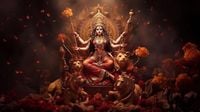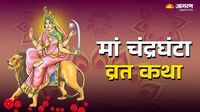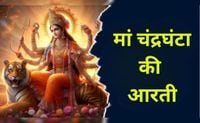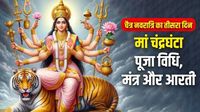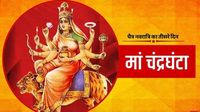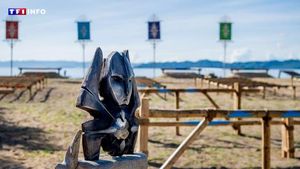As the vibrant festival of Chaitra Navratri unfolds, the third day is dedicated to the worship of Maa Chandraghanta, a revered form of Goddess Durga. Devotees across the country engage in rituals that not only honor this powerful deity but also seek her blessings for courage and prosperity.
Maa Chandraghanta, symbolizing power and peace, is depicted with a serene and gentle demeanor, bestowing happiness and tranquility upon her followers. According to the Devi Bhagwat Purana, her unique appearance features a half-moon adorning her forehead, which is the reason behind her name 'Chandraghanta'. Her radiant golden complexion and ten arms, each holding different weapons, signify her role as a fierce protector against evil.
On this auspicious day, which falls on April 1, 2025, devotees are encouraged to perform specific rituals to invoke the goddess's blessings. The worship begins with a morning bath followed by the wearing of clean clothes, a practice that symbolizes purity and devotion. A significant part of the ritual involves meditating on Maa Chandraghanta and setting up her idol or picture on a red or yellow cloth, accompanied by offerings of kumkum and akshat (unbroken rice).
As part of the puja, devotees prepare a special bhog (offering) of kheer, particularly saffron-infused kheer, which is considered especially pleasing to the goddess. Other offerings may include sweets made from milk, cloves, cardamom, and a variety of other delicacies. The worship is completed with the recitation of mantras, including the Durga Saptashati, and the singing of the aarti dedicated to Maa Chandraghanta.
It is believed that worshiping Maa Chandraghanta awakens the Manipur chakra, granting devotees remarkable spiritual energy. This practice is thought to dispel fear and negativity, ushering in peace and success in one’s life. Devotees report feeling a surge of confidence and courage, enabling them to tackle life's challenges more effectively.
According to traditional beliefs, the rituals associated with Maa Chandraghanta not only bring physical well-being but also enhance one’s social influence. The goddess is often invoked for protection from adversaries and for alleviating mental unrest. Her worship is particularly beneficial for those facing Mangal Dosha in their horoscopes, as it is believed to mitigate its effects.
Throughout the day, various auspicious timings are recommended for performing the puja. Brahma Muhurta, from 4:39 AM to 5:25 AM, is considered especially favorable, along with other significant time slots such as Pratah Sandhya and Abhijit Muhurta. These timings are thought to maximize the effectiveness of the rituals and enhance the blessings received.
The aarti dedicated to Maa Chandraghanta is a beautiful expression of devotion, encapsulating her divine qualities and the hopes of her devotees. Lyrics such as "जय मां चंद्रघंटा सुख धाम, पूर्ण कीजो मेरे सभी काम" resonate deeply, reflecting the heartfelt prayers for the fulfillment of desires and the attainment of peace.
As the day progresses, communities come together to celebrate this powerful form of the goddess, sharing stories of her valor and the significance of her divine intervention in the battle against evil. The legend of her emergence during the reign of the demon Mahishasura serves as a reminder of the triumph of good over evil, inspiring devotees to stand against injustice.
In conclusion, the worship of Maa Chandraghanta on the third day of Chaitra Navratri is not just a ritual; it is a profound expression of faith and a call for divine support in overcoming life's adversities. As devotees engage in these sacred practices, they reinforce their connection to the goddess and embrace the virtues of courage, peace, and prosperity she embodies.
